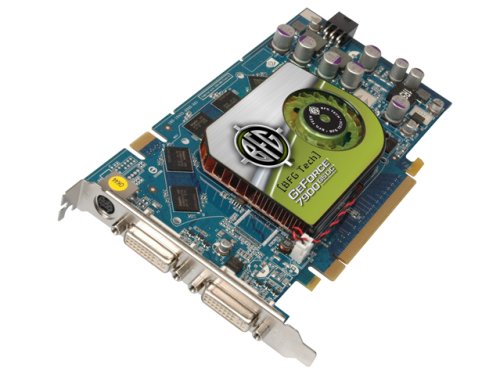The NVIDIA GeForce 7900 GS: A Closer Look
by Josh Venning on September 19, 2006 5:00 AM EST- Posted in
- GPUs
BFG

Our fourth 7900 GS we have for this review is the BFG GeForce 7900 GS OC.

As the "OC" implies, the card comes out-of-the-box with a factory overclock, and it happens to have the highest core clock of all of our 7900 GS cards in this review. The BFG 7900 GS OC's core clock is set at 540MHz, a 90MHz increase over the standard NVIDIA 7900 GS, with the memory clock the same as the reference (660MHz). This is an impressive factory overclock, and we are interested to see what kind of performance we will see with this card. Unfortunately, no games are included in the BFG 7900 GS OC's bundle, but the fact that this card is factory overclocked so high as well as its low price more than make up this.

Our fourth 7900 GS we have for this review is the BFG GeForce 7900 GS OC.

As the "OC" implies, the card comes out-of-the-box with a factory overclock, and it happens to have the highest core clock of all of our 7900 GS cards in this review. The BFG 7900 GS OC's core clock is set at 540MHz, a 90MHz increase over the standard NVIDIA 7900 GS, with the memory clock the same as the reference (660MHz). This is an impressive factory overclock, and we are interested to see what kind of performance we will see with this card. Unfortunately, no games are included in the BFG 7900 GS OC's bundle, but the fact that this card is factory overclocked so high as well as its low price more than make up this.










42 Comments
View All Comments
sum1 - Wednesday, September 20, 2006 - link
Let me clarify:
"The BFG 7900 GS OC's core clock is set at 520MHz, a 70MHz increase over the standard NVIDIA 7900 GS"
It’s listed at 540MHz everywhere else in this article (including the benchmarks).
DerekWilson - Tuesday, September 19, 2006 - link
For some reason, BFG's website lists it as 525MHz. We'll double check our sample, but we listed the speed of the card we reviewed.http://www.bfgtech.com/7900GS_256_PCIX.html">http://www.bfgtech.com/7900GS_256_PCIX.html
EVGA is actually EVGA despite the fact that people tend to lowercase the leading 'e'. Check their own press releases on their site.
http://www.evga.com/about/pressrelease/default.asp...">http://www.evga.com/about/pressrelease/...t.asp?re...
Maybe uniqueness can come in shades of blue if it can't be grey :-) I see your point, but sometimes taking a little liberty with language gives us the ability to succinctly convey something like the idea that "this is mostly the same as everything else with a slight difference in one area".
yacoub - Tuesday, September 19, 2006 - link
I really don't like the line graphs... very hard to read when more than three or four lines are close together. Get much more meaningful data much more quickly from traditional bar graphs or a simple table with numbers.DerekWilson - Tuesday, September 19, 2006 - link
the line graphs include a table -- just ignore the top part :-)the problem with bar graphs are that they don't clearly show trends between cards over different resolutions, they don't show the impact of increasing resolution for each card, and they take up qutie a bit more space.
we'd love to hear more good suggestions on ways we can better present our data though.
Questar - Tuesday, September 19, 2006 - link
Stacked bars do.
DerekWilson - Tuesday, September 19, 2006 - link
i think those are harder to read than line graphs.VooDooAddict - Tuesday, September 19, 2006 - link
I agree that they are harder to read. Persoanlly I like the way they show how the cards scale. Unfortunetly while it's nice to have all the data right there. I used to be able to show non-techie friends a page or two from your review to pointout the performance advantages of one video chipset over the other.With the new line graphs and data grids I need to make my own simple bar graphs from your data to show friends info relivant to thier purchase decision. (I would never re-publish these graphs with your data... just used to give non-techie friends better direction.)
As a side note. I personally know quite a few people out there debating over the current $100-$240 range: The new X1300 XT (Which is baqsicly a X1600 Pro), X1600 XT, 7600GS, 7600GT, X1900GT, 7900GS, 7900GT (with rebates) ... you might want to take note of these if you ever toss up more Low-Midrange buying guides.
yacoub - Tuesday, September 19, 2006 - link
"The EVGA 7900 GS's heat sink is slightly longer than the reference 7900 GS's heat sink and it has two gill-shaped cutouts exposing some copper ridges from the inside of the sink. Aside from that, the card has the signature EVGA black coloring, with their logo and card name in clear view on the face."You could also mention that it covers the RAM chips. That's kind of the point of its design and something nice to have.
Kougar - Tuesday, September 19, 2006 - link
Finally happy to see that eVGA only cooler get tested, looks like they knew what they were doing desiging it and using it on many of their G70 cards...Should also note the eVGA has had a $20 MIR on it for over a week, ties it with the XFX for best priced... but the warranty, non-stock cooler, and HDCP support ought to make it an obvious choice between the two.
mostlyprudent - Tuesday, September 19, 2006 - link
XFX makes a passively cooled 7950GT, but puts a fan on their 7900GS? Maybe it's a price issue (more expensive to passively cool a card and less profit margin at the $200 price range)?